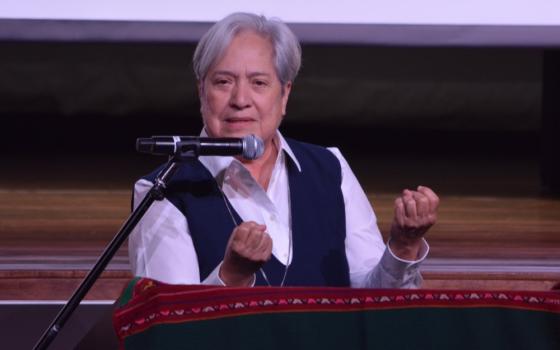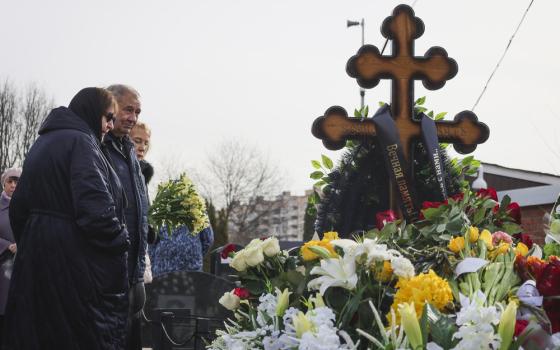Old men carrying wicker baskets lined with purple velvet came rushing toward me as I entered the Cathedral of St. John the Divine. Donations for completing the cathedral. I had three dollars, three subway tokens and a button. The old basket-holder returned the button. "Your change Ma'am," he smiled.
Ancient everything in this cathedral, poets buried under tiles, Bishops interred in walls. Surrounded by bones and blocks, reminded me of how empty a mind made of only concrete thought can become, and how alive when inhabited by endless souls filled with creative fire. This venerable Cathedral nourished the meaningful and artful.
I wandered about in that castle and thence came to a hall. Took it. Came to its end. There, a sign on a sudden door - Danger: No Admittance.
Women of a certain age tend to read such words as challenge rather than with chagrin. I cautiously opened the door ... I'm so glad I did.
The 'behind-the-scenes church,' that's what was behind the door, the highly symbolic parts and pieces of cast-off "church" that were not yet cared for at that time. Behind the door was an outdoor courtyard in complete disarray, filled literally with what appeared to be a sculptors' class of failed and failing, bold but broken sculptures from white marble. A full-size statue of St. Joseph with a penis was a little startling. Rather exhilarating, really, to remember him as so strong and generative - as opposed to the way he's oft been portrayed as though he were just some nice little unbuttered toast dipped in goat's milk.
I picked my way past wet tarps, past broken blacktop, past frayed ropes, rusted cans, past bolts, lumber and rebar black with gunk. And then, just behind a buttress appeared one of the saddest sights.
A magnificent old apple tree, but one so laden with apples, so fertile, so fecund, so heavy with thousands of enormous apples, its beautiful arms had split and broken all the way down to the ground.
No one had harvested this tree. The weight of her fruits alone had caused fresh yellow wood to splinter open clean down, her appled arms trailing rot onto the ground, that cider smell in the air.
Still. One hand to my heart, little tree talk prayer coming through my other hand, I touched her, this tree. She was still warm from sun of day. Still alive.
I could drag a barrel over, perhaps prop up some of her limbs maybe. I could manage to oof and roll a small block of stone to prop up another. Maybe that length of board could serve as a crutch.
Sometimes something is so heavy, you can't uplift it to help it unless you unburden it first. Too, she was like that. Harvest. Badly needed. Four beat-up wooden crates then, for the whole apples. I placed the crates at the chain-link fence that separated the churchyard from a sidewalk surging with passers-by. People could reach through the broken parts of the fence and take the good apples that way.
I picked apples and placed them on a large torn canvas painter's tarp I'd found. When the tarp was full, with the two closest ends tied around my waist, and the two far ends over my shoulder, I could slowly drag the apples to the crates at the fence line - moving as if one had a frail aunt in the back seat, not wanting her bones to clank together.
But now that the apple tree's boughs could be lifted, I had nothing to wrap them with. All surfaces - road, sidewalk, building walls covered over with rock and cement - no mud to make poultices for the tree's wounds. I remembered, though, the old man at the entrance with his bushel basket full of dollar bills.
I explained the situation to him and he immediately agreed. He would watch over. He would bring a small saw and carefully trim, not sever. He knew about mending trees; a fine old Italiano. Besides, after I told him about the unusual St. Joseph out back, I think Vesuvius erupting on Seventh Avenue couldn't have kept him from wanting to go see the manly statue for himself. Like he said, "You know, gotta go see just for the inspiration factor alone."
The Handless Maiden
And so it went. Years after coming upon the apple tree, it still felt as though I had stepped into the church's unconscious, into the teeming id, not that church specifically, but any church or temple ... wherever the blossoming body is seen as secondary, tertiary, as inconvenient or too time-consuming to know in depth or care for, as something inherently dangerous, born damaged, that misbehaves when left to itself, and must be tied down or broken down, severed, forgotten ... instead of as a precious, wild growing sensibility carrying ever so many gifts and an immaculate mystery ... all to be brought to more and more full harvest to the good over the years.
Sexuality. It was the broken apple tree, not the iconic St. Joseph which ticked open a door in my mind: It's not just in Genesis that the apple tree stands together with the talking serpent talk, drawing a bright line between ease with naked flesh and sudden shame of the body. And the centuries since seem to have only driven some to excesses in denigrating/fearing fullness of human sexuality.
Likewise, in mythos of eld, such as my old country family's version of the tale "The Handless Maiden" (Women Who Run with the Wolves), the apple tree, since time out of mind, has also represented the talent, sexuality, life-giving force of the young maiden, the mother and the old woman, all in one. She who is fertile, she who brings forth, she who - even when having gathered many years - still brings forth sweetest fruits imaginable ... and in abundance rather than only vaguely.
In "The Handless Maiden," the devil approaches a woodcutter, promising him endless riches if he will only give the devil what stands behind the man's barn. The man thinks, "Ah, it's only an old apple tree that stands there." He agrees to the tradeoff.
As he is rushing home to tell his wife, his rough clothes are magically replaced by rich velvets and silks. As his wife comes running to meet him, her plain scarf is replaced by a diamond tiara and her rags turn into a gown befitting a queen.
The man explains what a good bargain he has made. But the wife shrieks a death cry, "No! Behind the barn today stood our daughter. You have consigned our daughter to hell!"
And, in a few days' time, the devil shows up to claim the girl. The devil knew all along the father wasn't paying attention and did not register or cherish his daughter's true worth.
The story moves on through many episodes as it is a saga and is normally told in several parts over many nights' time. The first denouement occurs when the girl's purity of heart continually repels the devil so he cannot take her: He says her hands are too clean. That she must not bathe and she must allow herself to become dirty. But even then, she cries tears and her arms are made clean again, and thus she repels him as though a force field exists around her.
So, the devil tells the father that he has to cut off his daughter's arms so that the devil can then take her.
The father is horrified, but he follows through, for the devil threatens to take the father's life if he will not sacrifice his daughter. And thus, in one of the most horrendous episodes in ancient tales, the father hoists his sharp axe and severs his daughter's arms.
Still and yet, the devil is unable to take the girl. Her innate feminine depth repels him for the final time.
Arms and hands, in archetypal symbolism, are understood as one's ability to grasp complex matters, capacity to embrace ideas, ability to hold onto one's own thoughts and to draw things close to one, and also to repel what is not wanted. To be able to inquire, discern, fashion, feel, create: these are the properties of hands and arms.
In the tale, the girl, who has just burst into fruiting with her many talents in life, is disparaged and offered up for lucre, ease of life and material gain. She and the apple tree behind the father's barn are not protected even though each is fully filled with gifts. They are instead seen as nothings, present only to serve. It can be said, her gifts, not appreciated or seen, are thereby forfeited. She is not allowed to grasp or live her own deep and pure reality as a force of the feminine. The daughter's gifts are left to spoil on the ground.
In a similar manner, a woman's earthy and instinctual gifts of sexuality are routinely severed from the queue for self-development, and are given little place in cultural or religious consciousness, as well.
The severing of a woman's consciousness about her own knowledge of blessed sexuality, fertile in so many different ways - in order to have that grid placed over her, and early on, to benefit others - constantly defines her as the direct descendent of "the fallen first woman," who some hold as the downfall of all human beings from there forward to infinity.
That slander, by virtue of any child innocently having been born female, the luck of the draw, is the exact axe that severs the girl child's arms before she is yet an hour old. The presupposed alluring badness of females is set for life. The question that ought be answered definitively by all concerned is, Who does this severing of the deep feminine nature truly serve most?
The severing of a woman's arms prevents her from being able to grasp her own sexuality, to imagine her own holy body, her beautiful and deep sexual nature, her understanding of God through her own miraculous flesh.
Within churches, for about a decade now, there has been an ongoing movement toward a "theology of body." I think it has very good intent, although some who teach such are in no way mature enough in their own sexual knowledge, soul-centeredness or heart understanding.
I've heard many teaching human sexuality in a church context who have invested years in loving inquiry: They are constantly delving the mystery of the complex sexual nature in deep and worthy ways. Yet, rather bewilderingly, I've also come across some teaching sexuality for the church who wouldn't know a phallus from a fallacy, an ecstasy from an exorcism; and who think they've been to Havana just because they once smoked a Cuban cigar.
Forgive me. No matter how deputized, litmus-ized a church teacher may be via any presiding anyone ... to speak of sexuality or encyclicals on the nature of human sexuality as though either or both are electrical wiring diagrams or stepladders to rote holiness - or to presume that each individual does not have their own sexual radar and knowledge to the good - is most assuredly raising the axe and bringing it down on the arms of anyone who wishes and longs to burn in good ways for the incandescent sexuality inherent in the body ensouled.
It is true that many souls no longer know their own sexual nature, for it has been stripped from them. They have been shamed since childhood for carrying this radiant possibility rooted in the ensouled body. In essence they have lost the grasp of their most elemental and personal stories about their own bodies so cherished by the Creator.
THE VAGINA MONOLOGUES
Even so, still one might wonder, What stories of sexuality have been axed and shamed too? What stories have been amputated by the woodcutter father for personal, psychic or societal gain? Which critical stories about the nature of sexuality and all its radiance have been sold downriver by the mother who, as in the tale, intervenes too late, too weakly, who does not awaken to the father's greed for power, who did not say a definitive "No!" to the stealing of the burgeoning sexual and creative soul?
Which men's stories of sexuality, which women's stories of sexuality are not yet told? And what might occur when we see some of the most poignant, intimate and holy stories of sexuality told aloud instead of the perserverative, predictable X-rated claptrap we are inundated with each day?
We have some examples. For one, Eve Ensler's "The Vagina Monologues" has been produced for the last few years at the University of Notre Dame. It caused, for a time, the equivalent of angry villagers showing up, as my Uncle Luis, a refugee, used to say in his broken English, "wit burning porches and peach-forks."
But then there are the Father-Angels of the world. Like you yourselves no doubt, we together know several of these dear beings along with many Sister-Angels of this world too: They all carry some oddity of DNA that allows them to speak with clarity, mercy and calmness whilst others are chopping at the swale trying to tip the boat to one side only. Because many in the church hierarchy say they hold the ordained and the consecrated to a different bar, those who do speak are, as my grandmother used to put it, "bold for soul's sake."
One of these is Fr. Ed Ruetz of South Bend, Indiana. In a recent letter, Fr. Ed told me about an op-ed he published referencing "The Vagina Monologues" contretemps at Notre Dame. Rather than excoriate women and their stories about their own bodies, he wrote supporting Notre Dame's policy about "Catholic Identity and Academic Freedom," both of which he believes also include, amongst many other elements for discussion, the holy mysteries of sexuality, as well as injuries to understanding sexuality in depth …
"Just a month ago, for the third year in a row, conservative Catholics (including Notre Dame alumnae and alumni, and our Bishop) have made an issue of the annual production of Eve Ensler's play, The Vagina Monologues. They claim the play is against 'Catholic Identity' and therefore, not covered by academic freedom.
"The issue of Catholic Identity and Academic Freedom was debated widely three years ago. In 2006 [Notre Dame President] Father [John] Jenkins announced A Statement on the issue. It pointed out that the University is the place where controversial issues can and should be discussed. Both sides could speak on these issues. It was decided that the Monologues could be produced in a large classroom with no fee charged.
"In February a group of Bishops, including our Bishop and Cardinal [William] Levada (head of the Congregation of the Faith in Rome), moved their meeting to a convent on the south side of Mishawaka because the University was allowing The Monologues to be produced at the University.
"I began my article by saying: 'The underlying subconscious reasons why the Bishops moved their meeting from Notre Dame to the Convent of St. Francis was due to the patriarchal nature of the Catholic Church and an attitude of anti-feminism and sexism on the part of the Bishops.'
"I had attended the play in 2005 when the controversy began. I said I had an altogether different impression of the play than the Bishops. I said it was well within the bounds of Catholic Identity and should be allowed on campus because of the principle of academic freedom.
"I wrote ... in the South Bend Tribune, taking issue with the Bishops' decision. I said that they missed the entire point of the Monologues which is the worldwide violence against women by men. I said that they critiqued a few morally ambiguous vignettes and missed the central point of the play."
Would that the central point not be missed again and again about what has been done to women, rather than ad infinitum being affronted by what one imagines bad-bad women are once again supposedly "doing to us."
and the orcharder come cherish the fruiting tree.
CODA
Disclosure: A million years ago, Fr. Ed was my theology teacher in high school. Through some leak between the worlds, our paths crossed again recently - after more than 40 years. I remember the most poignant of what he or anyone else tried to teach me back then, but I particularly have never forgotten, ever, how Fr. Ed lived his life ... with such humanity toward all others: the reviled ones, the arrogant ones, the troubled ones, the shy ones, the talented ones, the introverts ... every soul he came across. He corrected, helped, pointed out, but with such quiet tenderness ... a teacher of the soul in the deepest sense.
"The Apple Tree: Sexual Body Theology" ©2008, C.P. Estés, All Rights Reserved. Permissions: projectscreener@aol.com



